|
Confederate Headquarters at Battle
of Gettysburg
General James Longstreet's Headquarters at the Battle of Gettysburg
| Gen. Longstreet's HQ marker |
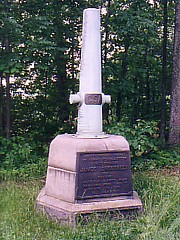
|
| Gettysburg NMP |
It was near this location on Warfield Ridge where General James Longstreet established his headquarters late on the afternoon of July 2. His infantry column had marched over 18 miles
to arrive near this point and deploy along Seminary Ridge to the north and Warfield Ridge to the south in preparation to strike the Union line. By this
time, Union General Daniel Sickles had moved troops of his Third Corps forward from Cemetery Ridge to establish a thin line of infantry and artillery from the Peach Orchard on the Emmitsburg Road to the Devil's Den, just west of Big Round Top. Union artillerymen had set up their guns in the
orchard and General Longstreet saw this as an opportunity to concentrate his artillery fire on their
position, blasting it from two directions at once. But it also presented a roadblock for the infantry that were to
attack up the Emmitsburg Road as General Lee wished and would necessarily alter Lee's original battle plan. Longstreet conferred
with his two division commanders, Generals John Bell Hood and Lafayette McLaws, near this location. He pointed out the general direction and course the attack was to
follow and gave orders for the attack to begin as soon as possible. All three generals realized the difficulty in making the
charge as their troops had to cross open farm fields with little or no concealment making their formations an inviting target
for the gunners at the orchard.
| Battle of Gettysburg, July 1-3, 1863 |
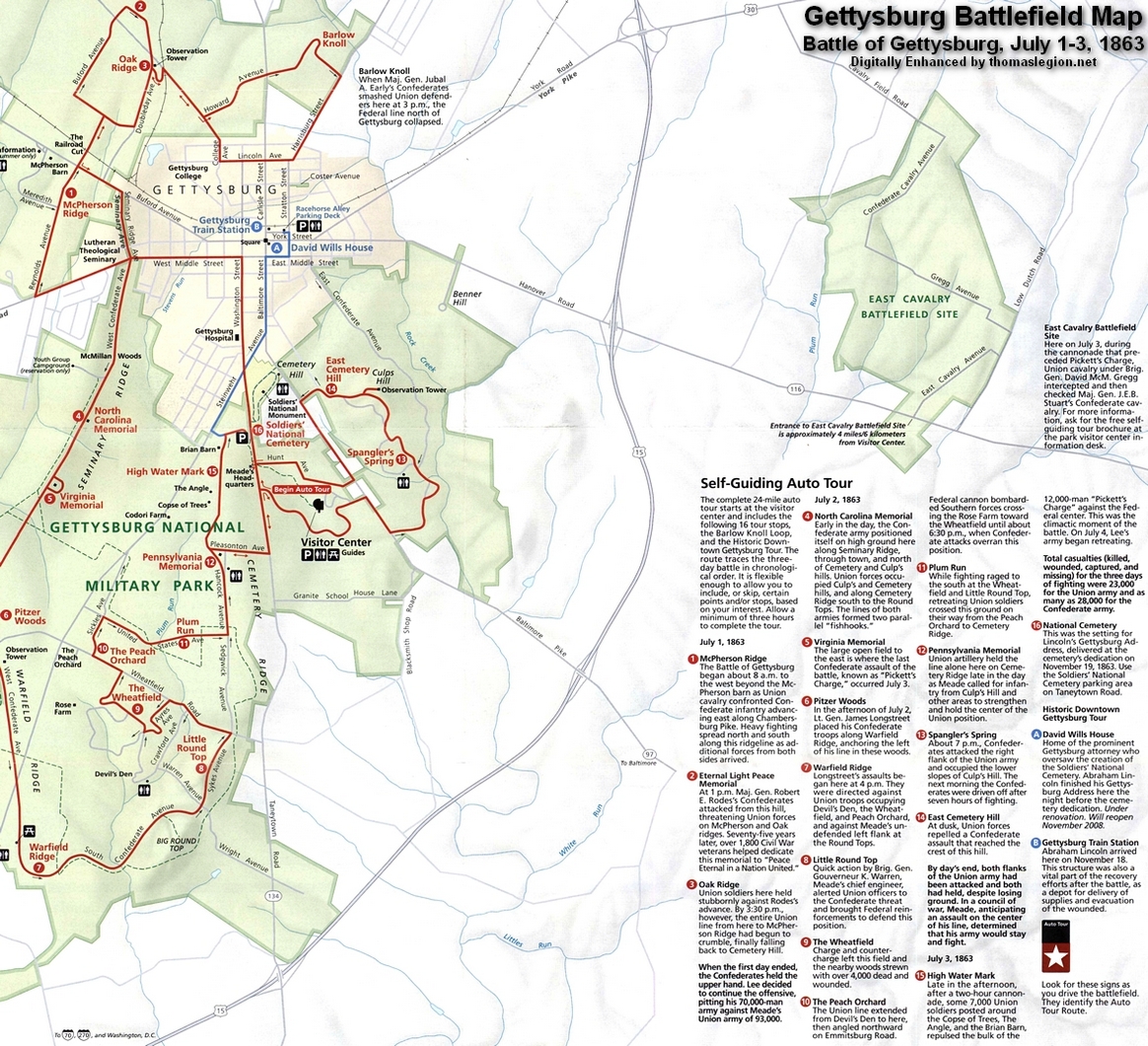
|
| Official Gettysburg Battlefield Map |
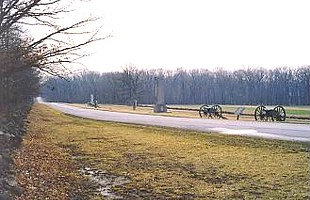
(Right) Picture of West Confederate Avenue today, looking south. Kershaw's
Confederates were positioned behind the stone wall at left. Gettysburg NMP.
This was the site where Brig. General Joseph Kershaw's Brigade of South Carolina soldiers formed their ranks behind the stone wall that still borders the woods, with the Georgia
brigade under Brig. General Paul Semmes 150 yards behind and also placed behind a stonewall. Kershaw walked through the woods
and peered ahead over the ground his troops were soon to cross. "I found (the Union troops) in superior force," the general
wrote, "strongly posted in the Peach Orchard, which bristled with artillery, with a main line of battle in their rear... to
Little Round Top. I placed my command in position under cover of the stone wall, and communicated the condition of matters to
Major General McLaws." The men were ordered to stay hidden behind the wall and for the flags to remain cased. Here the men
waited and watched Hood's troops as they passed moving to their starting points south of here. Volunteers took empty canteens
to fill from the well of a nearby farm house, while some men played cards, read letters from home, or slept after the long
march.
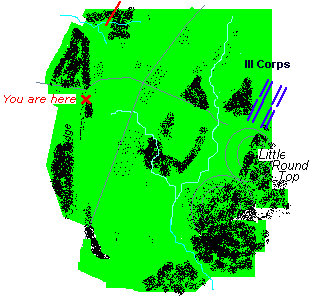
A few minutes before 4 P.M., Confederate artillerymen rolled their
guns into the fields and opened fire on the Union batteries near the Emmitsburg Road, concentrating on those in the Peach
Orchard. At that same moment, General Sickles had just about completed the movement
of the last of his Third Corps into his new advanced position and was conferring with General Meade who had finally arrived on the scene. The shriek of Southern cannon shells
from two directions stunned both officers. Sickles offered to withdraw but Meade replied that it was too late. The
commanding general ordered Sickles to hold his new line, and then issued orders to send reinforcements to Sickles' corps.
Meanwhile, General Longstreet rode to the southern end of his line where Hood's
troops had just stepped off toward the Round Tops. With red battle flags waving in the light afternoon breeze, brigade after
brigade moved out in solid battle lines toward the thin Union line. Some Union artillerymen turned their attention to these
infantry formations, very inviting targets for the big guns to hit with solid shot and shell. Longstreet, assured that his
infantry had moved off, next rode along the line of waiting troops back to this area where he conferred once again with General
McLaws. Over the next four hours his troops would be involved in some of the deadliest fighting yet seen during the war.
McLaw's Division was to follow upon the heels of Hood's division in the attack,
but it was not until 5 o'clock when General Kershaw received orders to move into the attack. His enthusiastic South Carolinians
clambered over the wall and as the men fell into place, the color sergeant of the 7th South Carolina unfurled the regiment's
flag. Within a matter of seconds, a Union battery found the range and sent a shell crashing into the 7th's color guard, killing
two and wounding three. Color bearers in the other regiments wisely chose to wait until the order to advance was given before
they unfurled their flags. With Semmes' Brigade close behind, Kershaw's South Carolinians moved off toward the Rose Farm and
Peach Orchard.
| The Flaharty Farm site from the Georgia Monument |
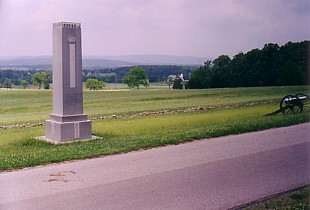
|
| Gettysburg NMP |
One of the many mysteries about Gettysburg is where General Longstreet established
his headquarters on July 2. Evidence points to a small farm that was located on the Millerstown Road, just west of the woods
on Warfield Ridge where his headquarters marker sits today. The farm was owned by J. Flaharty
and is now part of Eisenhower National Historic Site. The Flaharty farm was sold and the buildings were abandoned or destroyed
in the years following the Civil War, and very little is known about them or their use by Lee's corps commander who later
admitted, "My headquarters was in the saddle..." at Gettysburg. Sometime after 1900, a small wooden frame building at the
nearby Warfield Farm was labeled "General Longstreet's Headquarters" by the owner who purportedly relocated it to his property
from the Flaharty site. Yet there was nothing about that non-nondescript wood shed to prove this claim and the question of
any building having been used by General Longstreet as a headquarters remains unanswered to this very day.
| Battle of Gettysburg, Second Day, July 2, 1863 |
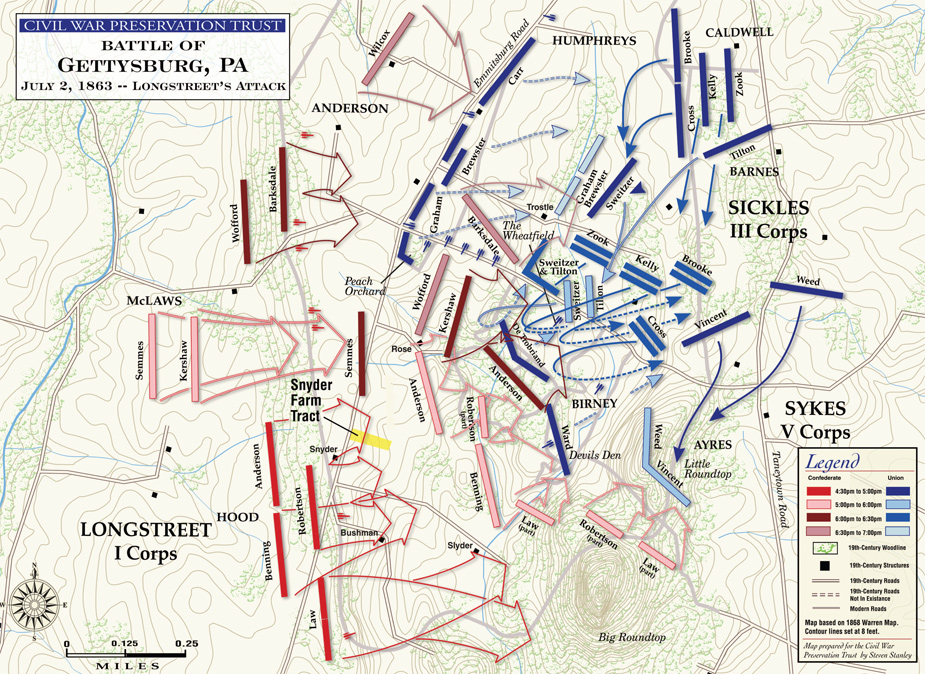
|
| Longstreet's Attack, Battle of Gettysburg, July 2, 1863 |
| South Carolina Memorial |
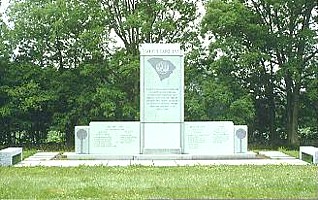
|
| Gettysburg NMP |
The Georgia Monument is located here as a tribute to the Georgians who served
at Gettysburg including many in Longstreet's Corps. It was dedicated on September 21, 1961. Also at this stop is the South
Carolina Memorial, placed here during the Civil War centennial celebration. The memorial stands at this location because of
it's relationship to General Kershaw's brigade, but like most state monuments it commemorates the services of all South Carolina
troops who served at Gettysburg.
(Right) South Carolina Memorial at Gettysburg National Military Park.
The state had ten volunteer infantry regiments, two cavalry regiments, and
four artillery batteries in the Army of Northern Virginia at Gettysburg and all saw heavy fighting during the three day battle. The monument's
unique design features the carved outline of the state and shield flanked by palmetto trees, the state symbol. Funds for the
monument were raised by private donations and through the Sons of Confederate Veterans. The memorial cost an estimated $20,000
and was dedicated by the governor of South Carolina on July 2, 1963.
Lee's Old War Horse
| General James Longstreet |
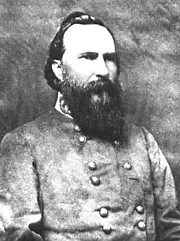
|
| Generals in Gray |
General Robert E. Lee referred to General James Longstreet as his "Old
War Horse."
Though a marker for General Longstreet's Headquarters stands at this location,
the general admittedly spent very little time here, preferring to remain mobile during the battle near his division commanders
or at General Lee's side near army headquarters on the grounds of the Lutheran Seminary. In the post-war era, General James Longstreet grew to become one of the more controversial personalities connected to
the Confederate defeat at the battle. At the height of Reconstruction in the 1870s, Longstreet joined the Republican Party.
It was not a popular decision among most Southerners who saw the Republicans as the party which pursued the war against the
South and attempted to punish the southern states with bitter policies during reconstruction.
As post-war debates became widespread as to exactly where the South
may have gone wrong, attention centered on the Battle of Gettysburg as the turning point. Lee refused to join in any such
debate and died in 1870 without any response to the discussion. Many Southern political leaders and former generals, including
Jubal Early and Sandie Pendleton, were quick to point out that Longstreet had not cooperated with Lee at Gettysburg by not
supporting his commander's wishes as fully as he should have. Longstreet responded with criticisms of Lee's field decisions
and strategy. By this time, the stature of Lee was so great and his abilities as a Southern commander so highly regarded that
many in the South saw Longstreet's comments as treachery. The war of words continued until the last days of General Longstreet's
life, though he was exonerated time and again by the veterans who had marched, fought, and bled under his command on many
a battlefield.
| Three days at the place known as Gettysburg |
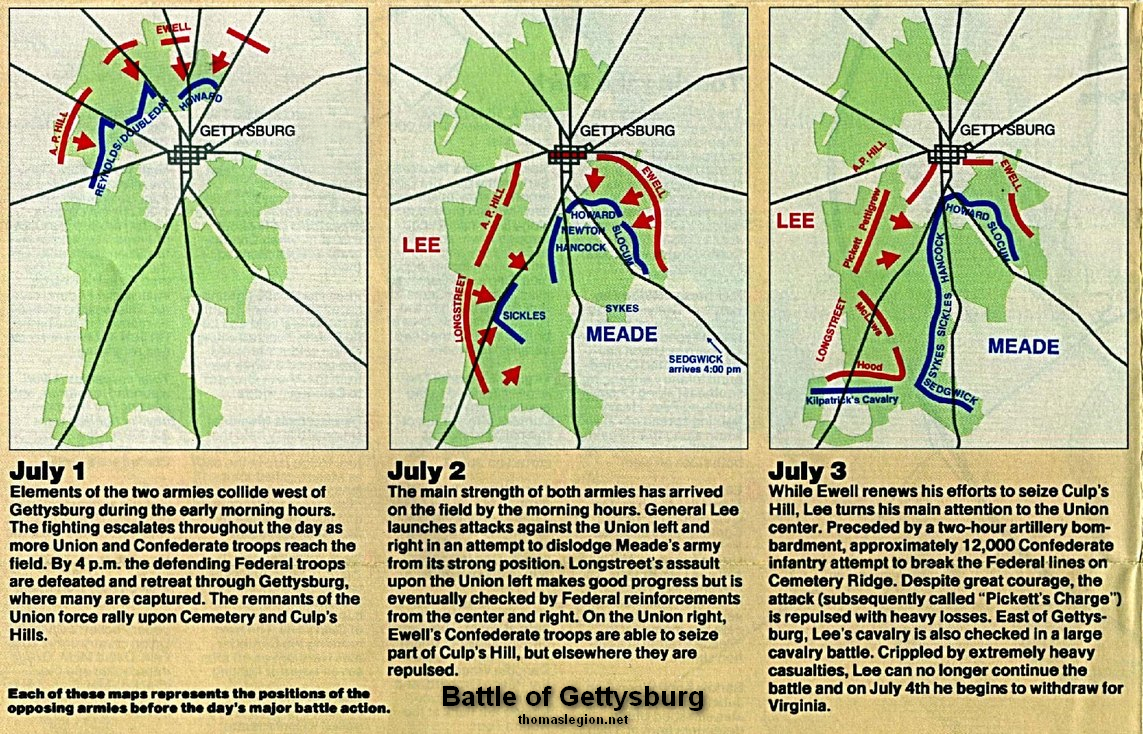
|
| Battle of Gettysburg, July 1-3, 1863 |
War Department Towers
| Longstreet Tower |
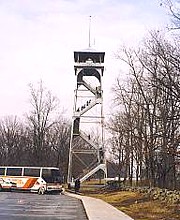
|
| Gettysburg NMP |
One of the last three remaining War Department-era observation towers stands
at this site and offers the visitor a panoramic view of the battlefield. Originally, there were five towers constructed by
the United States War Department on the battlefield and this is the only one built on West Confederate Avenue. From the observation
deck, one can appreciate the distance that Longstreet's Confederates had to cross to reach the Union positions at Little Round
Top, the Wheatfield and in the Peach Orchard. The tower also overlooks the farm that is today Eisenhower National Historic
Site, the retirement home of President Dwight D. Eisenhower. The farm buildings used by General Longstreet as a temporary
headquarters stood on the Eisenhower property, but they no longer exist.
The tower was the last major structure to be placed on West Confederate Avenue,
which was also laid out and paved by the US War Department at the turn of the century. William Robbins, a Confederate veteran
of the battle and one of the first battlefield commissioners, promoted the avenue so that Confederate artillery and infantry
positions could be marked. Robbins worked with original reports and documents while relying on eyewitness testimony from visiting
veterans to compose the tablets. This portion of West Confederate between Millerstown Road and the Emmitsburg Road is lined
with numerous Confederate battery positions as well as several state memorials and brigade markers.
Source: National Park Service; Gettysburg National Military Park
Recommended Reading: General James
Longstreet: The Confederacy's Most Controversial Soldier (Simon & Schuster). Description: This isn't the first biography to be written on Confederate General James Longstreet,
but it's the best--and certainly the one that pays the most attention to Longstreet's performance as a military leader. Historian
Jeffry D. Wert aims to rehabilitate Longstreet's reputation, which traditionally has suffered in comparison to those of Robert
E. Lee and Stonewall Jackson. Some Southern partisans have blamed Longstreet unfairly for the Confederate defeat at Gettysburg; Wert corrects the record. He is not “uncritical”
of Longstreet's record, but he rightly suggests that if Lee had followed Longstreet's advice, the battle's outcome might have
been different. Continued below...
The facts of
history cannot be changed, however, and Wert musters them on these pages to advance a bold claim: "Longstreet, not Jackson,
was the finest corps commander in the Army of Northern Virginia; in fact, he was arguably the best corps commander in the
conflict on either side." Wert describes his subject as strategically aggressive, but tactically reserved. The bulk of the
book appropriately focuses on the Civil War, but Wert also briefly delves into Longstreet's life before and after it. Most
interestingly, it was framed by a friendship with Ulysses S. Grant, formed at West Point
and continuing into old age. Longstreet even served in the Grant administration--an act that called into question his loyalty
to the Lost Cause, and explains in part why Wert's biography is a welcome antidote to much of what has been written about
this controversial figure.
Recommended Reading: General Lee's
Army: From Victory to Collapse. Review: You cannot say that University of North Carolina
professor Glatthaar (Partners in Command) did not do his homework in this massive examination of the Civil War–era lives
of the men in Robert E. Lee's Army of Northern Virginia. Glatthaar spent nearly 20 years examining and ordering primary source
material to ferret out why Lee's men fought, how they lived during the war, how they came close to winning, and why they lost.
Glatthaar marshals convincing evidence to challenge the often-expressed notion that the war in the South was a rich man's
war and a poor man's fight and that support for slavery was concentrated among the Southern upper class. Continued below...
Lee's army
included the rich, poor and middle-class, according to the author, who contends that there was broad support for the war in
all economic strata of Confederate society. He also challenges the myth that because Union forces outnumbered and materially
outmatched the Confederates, the rebel cause was lost, and articulates Lee and his army's acumen and achievements in the face
of this overwhelming opposition. This well-written work provides much food for thought for all Civil War buffs.
Recommended Reading: Lee's Lieutenants: A Study in Command (912 pages). Description: Hailed as one of the greatest Civil War books, this exhaustive study is an abridgement
of the original three-volume version. It is a history of the Army of Northern Virginia from the first shot fired to the
surrender at Appomattox - but what makes this book unique
is that it incorporates a series of biographies of more than 150 Confederate officers. The book discusses in depth all the
tradeoffs that were being made politically and militarily by the South. Continued below...
The book does
an excellent job describing the battles, then at a critical decision point in the battle, the book focuses on an officer -
the book stops and tells the biography of that person, and then goes back to the battle and tells what information the officer
had at that point and the decision he made. At the end of the battle, the officers decisions are critiqued based on what he
"could have known and what he should have known" given his experience, and that is compared with 20/20 hindsight. "It is an
incredibly well written book!"
Recommended Reading: Brigades
of Gettysburg: The Union and Confederate Brigades at the Battle
of Gettysburg (Hardcover) (704 Pages). Description:
While the battle of Gettysburg is certainly the
most-studied battle in American history, a comprehensive treatment of the part played
by each unit has been ignored. Brigades of Gettysburg fills this void by
presenting a complete account of every brigade unit at Gettysburg
and providing a fresh perspective of the battle. Using the words of enlisted men and officers, the author and renowned Civil War
historian, Bradley Gottfried, weaves a fascinating narrative of the role played by every brigade at the famous three-day battle,
as well as a detailed description of each brigade unit. Continued below...
Organized by
order of battle, each brigade is covered in complete and exhaustive detail: where it fought, who commanded, what constituted
the unit, and how it performed in battle. Innovative in its approach and comprehensive in its coverage, Brigades of Gettysburg is certain to be a classic and indispensable reference for the battle of Gettysburg
for years to come.
Recommended Reading: Gettysburg Heroes: Perfect Soldiers, Hallowed Ground (Hardcover). Description: The Civil War generation saw its world in ways startlingly different from our own. In these
essays, Glenn W. LaFantasie examines the lives and experiences of several key personalities who gained fame during and after
the war. The battle of Gettysburg is the thread that ties
these Civil War lives together. Gettysburg was a personal
turning point, though each person was affected differently. Continued below…
Largely biographical
in its approach, the book captures the human drama of the war and shows how this group of individuals--including Abraham Lincoln,
James Longstreet, Joshua Lawrence Chamberlain, William C. Oates, and others--endured or succumbed to the war and, willingly
or unwillingly, influenced its outcome. Concurrently, it shows how the war shaped the lives of these individuals, putting
them through ordeals they never dreamed they would face or survive.
Recommended Reading:
Civil War High Commands (1040 pages)
(Hardcover). Description: Based on nearly five decades of research, this magisterial work
is a biographical register and analysis of the people who most directly influenced the course of the Civil War, its high commanders.
Numbering 3,396, they include the presidents and their cabinet members, state governors, general officers of the Union and Confederate armies (regular, provisional, volunteers, and militia), and admirals and commodores
of the two navies. Civil War High Commands will become a cornerstone reference work on these personalities and the
meaning of their commands, and on the Civil War itself. Continued below...
Errors of fact and interpretation concerning the high
commanders are legion in the Civil War literature, in reference works as well as in narrative accounts. The present work brings
together for the first time in one volume the most reliable facts available, drawn from more than 1,000 sources and including
the most recent research. The biographical entries include complete names, birthplaces, important relatives, education, vocations,
publications, military grades, wartime assignments, wounds, captures, exchanges, paroles, honors, and place of death and interment.
In addition to its main component, the biographies,
the volume also includes a number of essays, tables, and synopses designed to clarify previously obscure matters such as the
definition of grades and ranks; the difference between commissions in regular, provisional, volunteer, and militia services;
the chronology of military laws and executive decisions before, during, and after the war; and the geographical breakdown
of command structures. The book is illustrated with 84 new diagrams of all the insignias used throughout the war and with
129 portraits of the most important high commanders.
Recommended Reading: Pickett, Leader of the Charge: A Biography of General George E. Pickett, C.S.A.
Publishers Weekly: This first modern biography of the man who led the final Confederate attack at Gettysburg depicts neither
an archetypical cavalier nor a shallow incompetent. Though Pickett's promotion owed something to the patronage of his superior
Lt. Gen. James Longstreet, he had an excellent record of brigade command and did as well on July 3, 1863, as anyone was likely
to have done in the circumstances. Continued below...
Nevertheless, Pickett lost the confidence of Robert E. Lee and spent most of the rest of the war on peripheral
assignments in North Carolina and southern Virginia. Performing adequately under direct supervision, Pickett showed no aptitude
for independent command despite some successes, notably in organizing the defenses of Petersburg in 1864. Longacre's sympathy
for his subject leads him both to overestimate Pickett's military capacities and to understate Gettysburg's impact on a man
who in its aftermath arguably suffered from what is now called post-traumatic stress disorder. This work is still a useful
addition to the literature on Confederate command in the Civil War.
|

